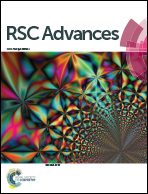An efficient, green synthesis of novel regioselective and stereoselective indan-1,3-dione grafted spirooxindolopyrrolizidine linked 1,2,3-triazoles via a one-pot five-component condensation using PEG-400†
Abstract
An efficient synthesis of highly diversified novel functionalized indan-1,3-dione grafted spirooxindolopyrrolizidine linked 1,2,3-triazole conjugates via a one-pot, five-component condensation of indan-1,3-diones, aldehydes, sarcosine, N-propargylated isatin and azides using Cu(I) as a catalyst in PEG-400 as the reaction medium is reported. The reaction proceeds in a highly regio- and stereoselective manner involving a catalyst free Knoevenagel condensation followed by two successive 1,3-dipolar cycloaddition reactions. This protocol is suitable for aromatic, heteroaromatic and aliphatic aldehydes. In situ generation of azomethine ylides and their selectivity towards exocyclic double bonds result in highly functionalized molecular hybrids. All the compounds are obtained in high yield (6a–6s) and were characterized by spectroscopic methods.


 Please wait while we load your content...
Please wait while we load your content...